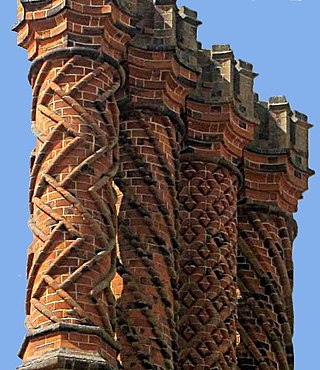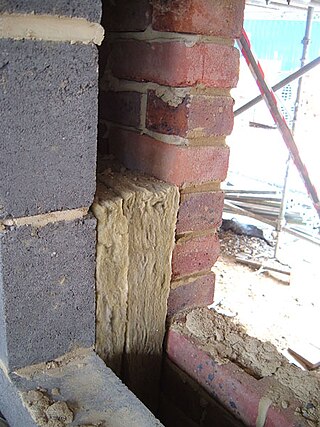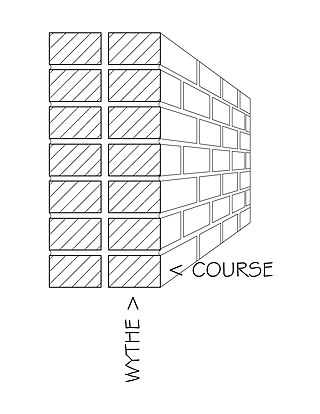Related Research Articles

Masonry is the craft of building a structure with brick, stone, or similar material, including mortar plastering which are often laid in, bound and pasted together by mortar; the term masonry can also refer to the building units themselves. The common materials of masonry construction are bricks and building stone such as marble, granite, and limestone, cast stone, concrete blocks, glass blocks, and adobe. Masonry is generally a highly durable form of construction. However, the materials used, the quality of the mortar and workmanship, and the pattern in which the units are assembled can substantially affect the durability of the overall masonry construction. A person who constructs masonry is called a mason or bricklayer. These are both classified as construction trades.

A wall is a structure and a surface that defines an area; carries a load; provides security, shelter, or soundproofing; or, is decorative. There are many kinds of walls, including:

A floor is the bottom surface of a room or vehicle. Floors vary from simple dirt in a cave to many layered surfaces made with modern technology. Floors may be stone, wood, bamboo, metal or any other material that can support the expected load.

A railway track or railroad track, also known as a train track or permanent way, is the structure on a railway or railroad consisting of the rails, fasteners, railroad ties and ballast, plus the underlying subgrade. It enables trains to move by providing a dependable surface for their wheels to roll upon. Early tracks were constructed with wooden or cast iron rails, and wooden or stone sleepers; since the 1870s, rails have almost universally been made from steel.

Portcullis House (PCH) is an office building in Westminster, London, England, that was commissioned in 1992 and opened in 2001 to provide offices for 213 members of the Parliament of the United Kingdom and their staff. The public entrance is on the Embankment. Part of the Parliamentary Estate, the building augments limited space in the Palace of Westminster and surroundings.

Brickwork is masonry produced by a bricklayer, using bricks and mortar. Typically, rows of bricks called courses are laid on top of one another to build up a structure such as a brick wall.

Tilt-up,tilt-slab or tilt-wall is a type of building and a construction technique using concrete. Though it is a cost-effective technique with a shorter completion time, poor performance in earthquakes has mandated significant seismic retrofit requirements in older buildings.

A concrete slab is a common structural element of modern buildings, consisting of a flat, horizontal surface made of cast concrete. Steel-reinforced slabs, typically between 100 and 500 mm thick, are most often used to construct floors and ceilings, while thinner mud slabs may be used for exterior paving .

A countertop, also counter top, counter, benchtop, worktop or kitchen bench, bunker is a raised, firm, flat, and horizontal surface. They are built for work in kitchens or other food preparation areas, bathrooms or lavatories, and workrooms in general. The surface is frequently installed upon and supported by cabinets, positioned at an ergonomic height for the user and the particular task for which it is designed. A countertop may be constructed of various materials with different attributes of functionality, durability and aesthetics, and may have built-in appliances, or accessory items relative to the intended application.

A cavity wall is a type of wall that has a hollow center. They can be described as consisting of two "skins" separated by a hollow space (cavity). The skins typically are masonry, such as brick or cinder block. Masonry is an absorbent material that can slowly draw rainwater or even humidity into the wall. One function of the cavity is to drain water through weep holes at the base of the wall system or above windows. The weep holes allow wind to create an air stream through the cavity that exports evaporated water from the cavity to the outside. Usually, weep holes are created by separating several vertical joints approximately two meters apart at the base of each story. Weep holes are also placed above windows to prevent dry rot of wooden window frames. A cavity wall with masonry as both inner and outer skins is more commonly referred to as a double wythe masonry wall.
The Barra system is a passive solar building technology developed by Horazio Barra in Italy. It uses a collector wall to capture solar radiation in the form of heat. It also uses the thermosiphon effect to distribute the warmed air through channels incorporated into the reinforced concrete floors, warming the floors and hence the building. Alternatively, in hot weather, cool nighttime air can be drawn through the floors to chill them in a form of air conditioning.

Damp proofing in construction is a type of moisture control applied to building walls and floors to prevent moisture from passing into the interior spaces. Dampness problems are among the most frequent problems encountered in residences.

A course is a layer of the same unit running horizontally in a wall. It can also be defined as a continuous row of any masonry unit such as bricks, concrete masonry units (CMU), stone, shingles, tiles, etc.
Beam and block is a construction method to support flooring, especially for ground floors as well as multi story buildings. It is made of cast concrete, one piece of which is a prestressed concrete beam, which can be an inverted T-shaped beam, or lintel, the other piece being a simple rectangular block. The beams are placed at regular intervals and the blocks placed between them. They form a support for the next layer of flooring materials.
Centre of Science and Technology For Rural Development (COSTFORD) is a Thrissur city-based organisation that gives technological assistance to people in alternative building technology. The organization strives to change the social, economic and political position of the poor by providing low-cost and eco-friendly housing technology using participatory, transparent and gender-sensitive processes. COSTFORD's headquarters are in Thrissur, and it operates from another 15 sub-centers, 14 in Kerala and 1 in Gurgaon.

Lift slab construction is a method of constructing concrete buildings by casting the floor or roof slab on top of the previous slab and then raising (jacking) the slab up with hydraulic jacks. This method of construction allows for a large portion of the work to be completed at ground level, negating the need to form floor work in place. The ability to create monolithic concrete slabs makes the lift slab construction technique useful in quickly creating structures with repetitive form work, like parking ramps.
The McCrossins Mill is a heritage-listed former mill and store and now museum at Salisbury Street, Uralla, Uralla Shire, New South Wales, Australia. It was designed by John McCrossin and built by Unknown. The property is owned by Uralla Historical Society Inc. It was added to the New South Wales State Heritage Register on 2 April 1999.

The Edificio del Seguro Médico is a commercial building in El Vedado, Havana. Built between 1955 and 1958, it was designed as a mixed use building for apartments and offices for the headquarters of the National Medical Insurance Company by Antonio Quintana Simonetti.